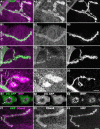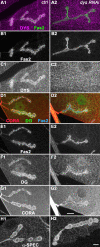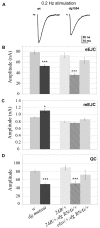Muscle dystroglycan organizes the postsynapse and regulates presynaptic neurotransmitter release at the Drosophila neuromuscular junction
- PMID: 18446215
- PMCID: PMC2323113
- DOI: 10.1371/journal.pone.0002084
Muscle dystroglycan organizes the postsynapse and regulates presynaptic neurotransmitter release at the Drosophila neuromuscular junction
Abstract
Background: The Dystrophin-glycoprotein complex (DGC) comprises dystrophin, dystroglycan, sarcoglycan, dystrobrevin and syntrophin subunits. In muscle fibers, it is thought to provide an essential mechanical link between the intracellular cytoskeleton and the extracellular matrix and to protect the sarcolemma during muscle contraction. Mutations affecting the DGC cause muscular dystrophies. Most members of the DGC are also concentrated at the neuromuscular junction (NMJ), where their deficiency is often associated with NMJ structural defects. Hence, synaptic dysfunction may also intervene in the pathology of dystrophic muscles. Dystroglycan is a central component of the DGC because it establishes a link between the extracellular matrix and Dystrophin. In this study, we focused on the synaptic role of Dystroglycan (Dg) in Drosophila.
Methodology/principal findings: We show that Dg was concentrated postsynaptically at the glutamatergic NMJ, where, like in vertebrates, it controls the concentration of synaptic Laminin and Dystrophin homologues. We also found that synaptic Dg controlled the amount of postsynaptic 4.1 protein Coracle and alpha-Spectrin, as well as the relative subunit composition of glutamate receptors. In addition, both Dystrophin and Coracle were required for normal Dg concentration at the synapse. In electrophysiological recordings, loss of postsynaptic Dg did not affect postsynaptic response, but, surprisingly, led to a decrease in glutamate release from the presynaptic site.
Conclusion/significance: Altogether, our study illustrates a conservation of DGC composition and interactions between Drosophila and vertebrates at the synapse, highlights new proteins associated with this complex and suggests an unsuspected trans-synaptic function of Dg.
Conflict of interest statement
Figures









Similar articles
-
Defects in neuromuscular junction structure in dystrophic muscle are corrected by expression of a NOS transgene in dystrophin-deficient muscles, but not in muscles lacking alpha- and beta1-syntrophins.Hum Mol Genet. 2004 Sep 1;13(17):1873-84. doi: 10.1093/hmg/ddh204. Epub 2004 Jul 6. Hum Mol Genet. 2004. PMID: 15238508
-
Maturation and maintenance of the neuromuscular synapse: genetic evidence for roles of the dystrophin--glycoprotein complex.Neuron. 2000 Feb;25(2):279-93. doi: 10.1016/s0896-6273(00)80894-6. Neuron. 2000. PMID: 10719885
-
Chimaeric mice deficient in dystroglycans develop muscular dystrophy and have disrupted myoneural synapses.Nat Genet. 1999 Nov;23(3):338-42. doi: 10.1038/15519. Nat Genet. 1999. PMID: 10610181
-
The molecular cross talk of the dystrophin-glycoprotein complex.Ann N Y Acad Sci. 2018 Jan;1412(1):62-72. doi: 10.1111/nyas.13500. Epub 2017 Oct 25. Ann N Y Acad Sci. 2018. PMID: 29068540 Review.
-
Dystroglycan and muscular dystrophies related to the dystrophin-glycoprotein complex.Ann Ist Super Sanita. 2003;39(2):173-81. Ann Ist Super Sanita. 2003. PMID: 14587215 Review.
Cited by
-
Uncovering molecular biomarkers that correlate cognitive decline with the changes of hippocampus' gene expression profiles in Alzheimer's disease.PLoS One. 2010 Apr 13;5(4):e10153. doi: 10.1371/journal.pone.0010153. PLoS One. 2010. PMID: 20405009 Free PMC article.
-
New dystrophin/dystroglycan interactors control neuron behavior in Drosophila eye.BMC Neurosci. 2011 Sep 26;12:93. doi: 10.1186/1471-2202-12-93. BMC Neurosci. 2011. PMID: 21943192 Free PMC article.
-
Hyperthermic seizures and aberrant cellular homeostasis in Drosophila dystrophic muscles.Sci Rep. 2011;1:47. doi: 10.1038/srep00047. Epub 2011 Jul 28. Sci Rep. 2011. PMID: 22355566 Free PMC article.
-
On the Teneurin track: a new synaptic organization molecule emerges.Front Cell Neurosci. 2015 May 27;9:204. doi: 10.3389/fncel.2015.00204. eCollection 2015. Front Cell Neurosci. 2015. PMID: 26074772 Free PMC article. Review.
-
Flightless flies: Drosophila models of neuromuscular disease.Ann N Y Acad Sci. 2010 Jan;1184:e1-20. doi: 10.1111/j.1749-6632.2010.05432.x. Ann N Y Acad Sci. 2010. PMID: 20329357 Free PMC article. Review.
References
-
- Ibraghimov-Beskrovnaya O, Ervasti JM, Leveille CJ, Slaughter CA, Sernett SW, et al. Primary structure of dystrophin-associated glycoproteins linking dystrophin to the extracellular matrix. Nature. 1992;355:696–702. - PubMed
-
- Ibraghimov-Beskrovnaya O, Milatovich A, Ozcelik T, Yang B, Koepnick K, et al. Human dystroglycan: skeletal muscle cDNA, genomic structure, origin of tissue specific isoforms and chromosomal localization. Hum Mol Genet. 1993;2:1651–1657. - PubMed
Publication types
MeSH terms
Substances
LinkOut - more resources
Full Text Sources
Molecular Biology Databases

